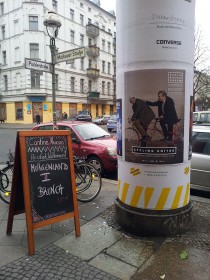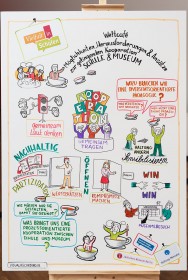The last few weeks have been full of hectic hustle and bustle, with boxes being passed from hand to hand, examined, unpacked, and sorted through. Such a variety of objects emerged from their cases and seemed to be disseminating in every direction through the museum.

© Jewish Museum Berlin, photo: Gelia Eisert
Blue prints were spread out over a long, dark red sheet. Words seemed to glow in them – was it “tekhelet” or “argaman” or both? And what do they mean anyway?

© Jewish Museum Berlin, photo: Gelia Eisert
A “magic” card appeared in a kitchenette. Suddenly everything was kosher: the sink, the refrigerator, the dishes, the whole kitchen. The artist promised it would be, and thus it happened. → continue reading
Pessach is approaching – the festival of exodus and freedom. This year, there is less talk of having the festive meal at large community gatherings. It is obvious, although unspoken, that smaller gatherings in the home make more sense. We are becoming alienated from our community centers through fear. Keep a low profile. Don’t speak Hebrew on the streets. Some people are removing the mezuzah from their front doorposts, a traditional object that visibly identifies a Jewish household. There is a mood of caution and nervous apprehension.
How did it get to this point?

Advertisement with Imam Ferid Heider and Rabbi Daniel Alter for the “Cycling Unites”-Critical-Mass-Tour in Berlin on 22 March 2015, photo: Michal Friedlander
June, 2014
A drunken man rolls slowly off the train platform and plops onto the tracks at Friedrichstrasse station. Around sixty people witness the moment and look away, hoping that someone else will solve the stinky, awkward problem. And so it was. An Italian and an Israeli jumped down to haul the semi-conscious man to safety. The passengers walked around the startled little group, pressing forward to make the oncoming train.
July 2014
Dinner party small talk. The discussions nearest me are taking a more political turn and I am just not in the mood to talk about Israel. Too late. The young man next to me asks if I saw the recent pro-Palestinian demonstration on the Kurfürstendamm? He becomes very still and lowers his voice. → continue reading

A “graphic recording” of the ways in which schools and museums can cooperate more closely on diversity issues © JMB, photo: Jule Roehr
We learned a lot in the course of our three-year “Vielfalt in Schulen” [ViS] program, which the Jewish Museum Berlin [JMB] carried out in cooperation with the Deutsche Kinder- und Jugendstiftung [DKJS, German Foundation for Children and Young People], with funding courtesy of the Stiftung Mercator [Mercator Foundation]. Journalist Alke Wierth of the national daily paper, tageszeitung, recently helped us weigh up the results.
Alke Wierth: Looking back on what you had in mind when launching the “ViS” program, can you recall at which point you first thought: “Things are not going the way we planned?”
Rosa Fava, project leader, JMB: It was right at the start, at one of the meetings with the participating schools, where we discussed their expectations of the program. A lot of the stuff talked about there made me wonder: What on earth has this to do with our concept?
For example?
→ continue reading



